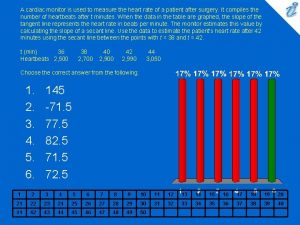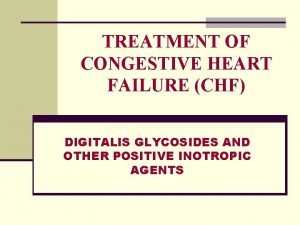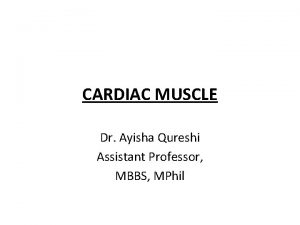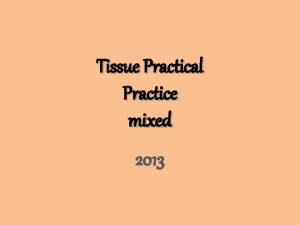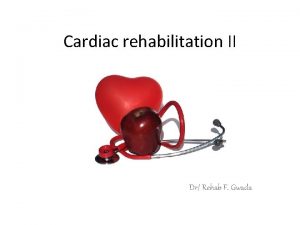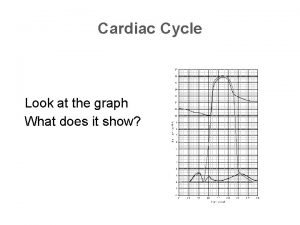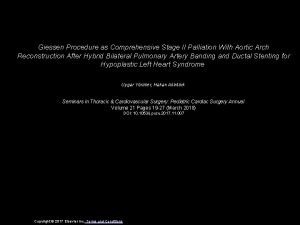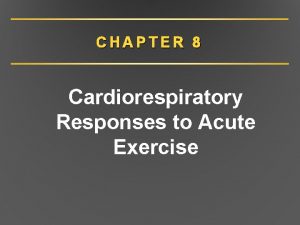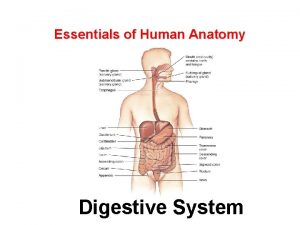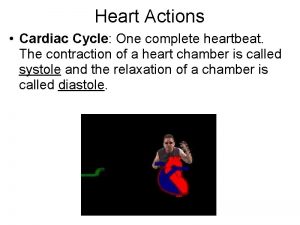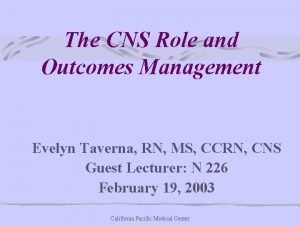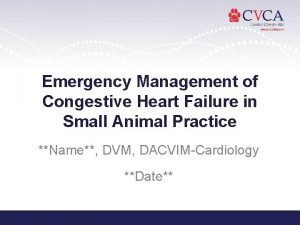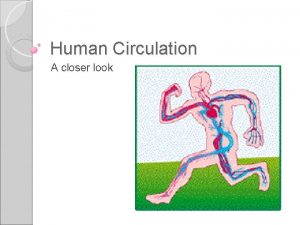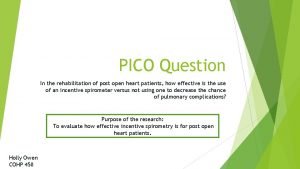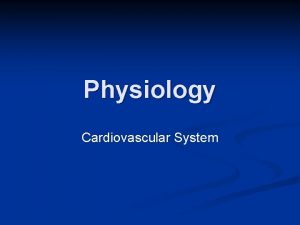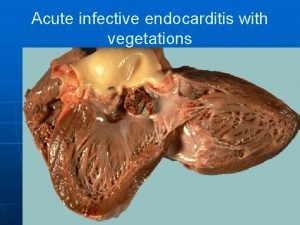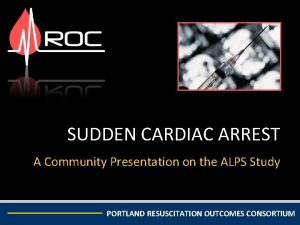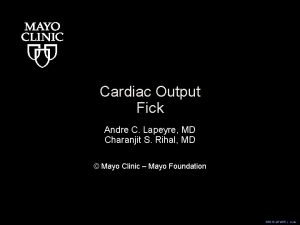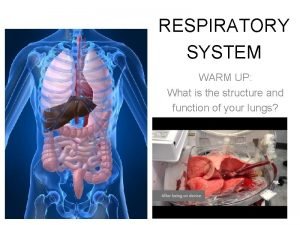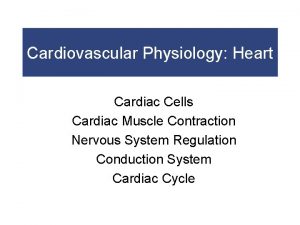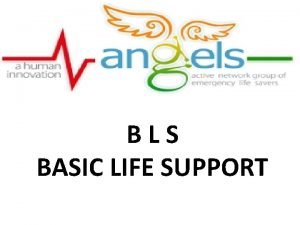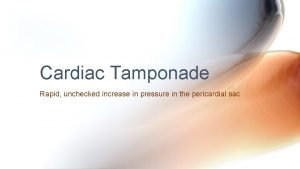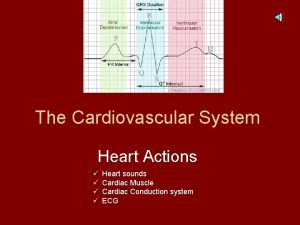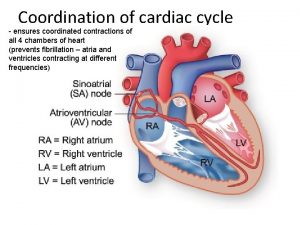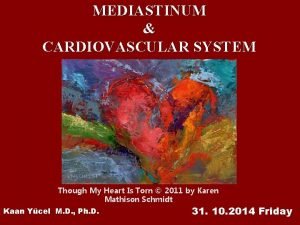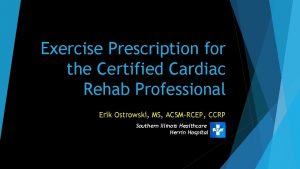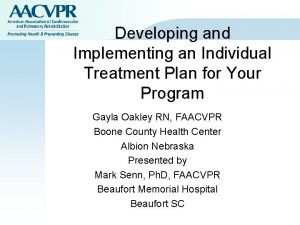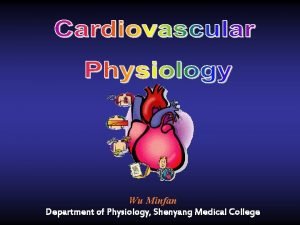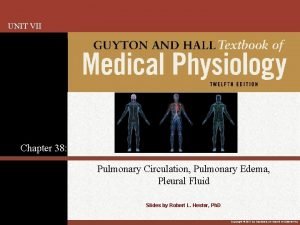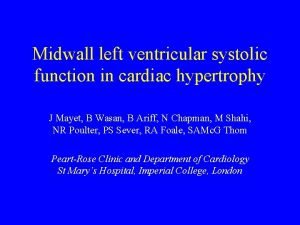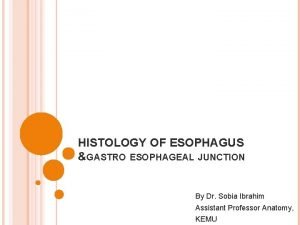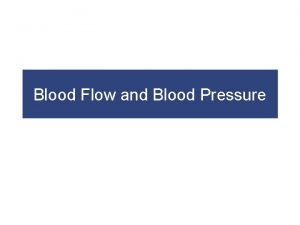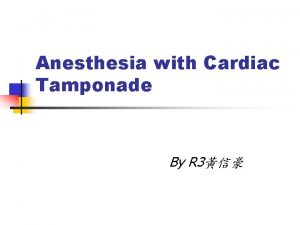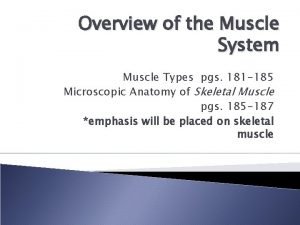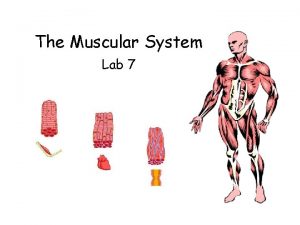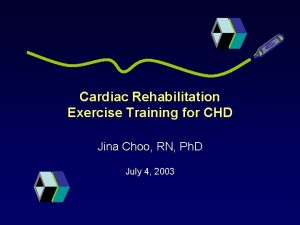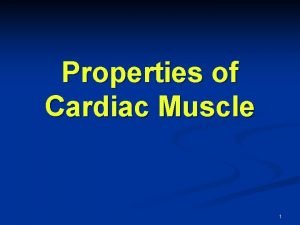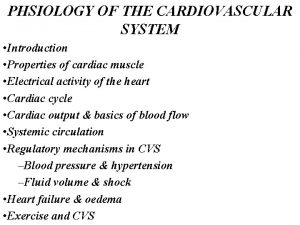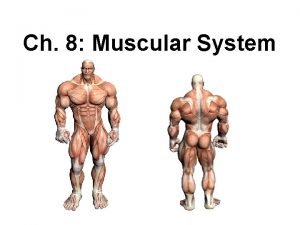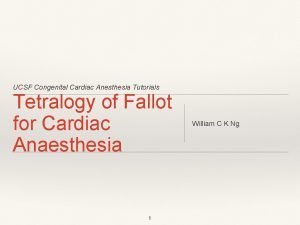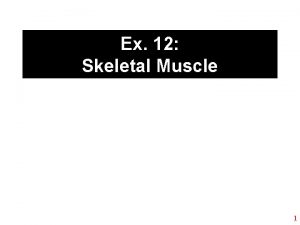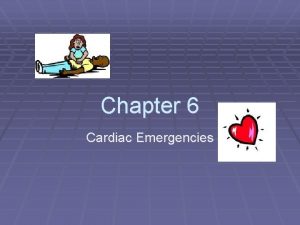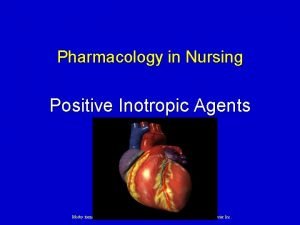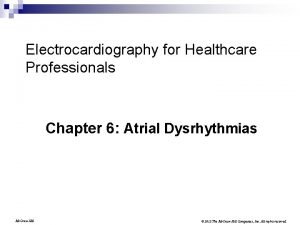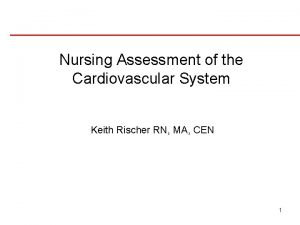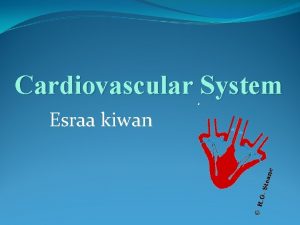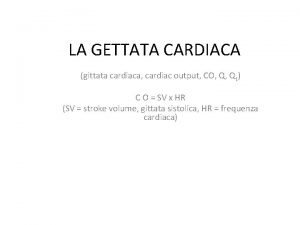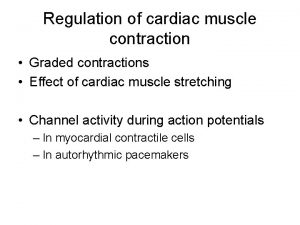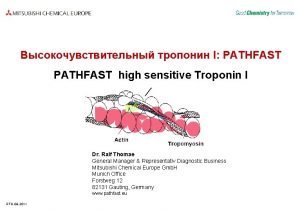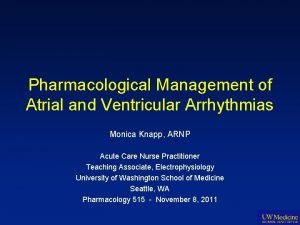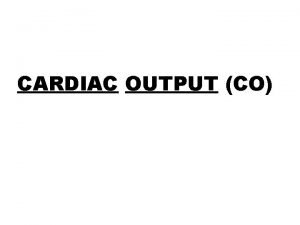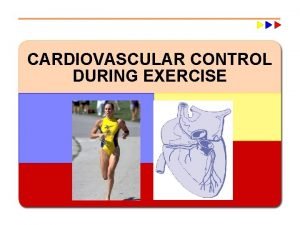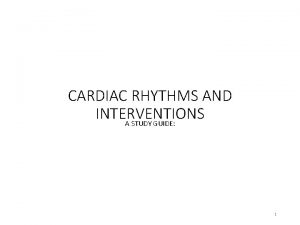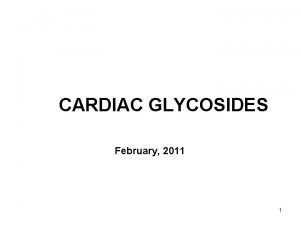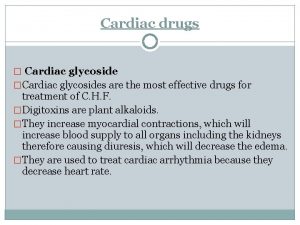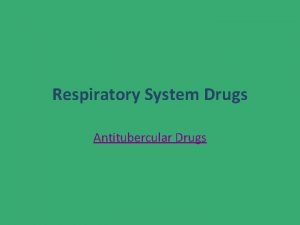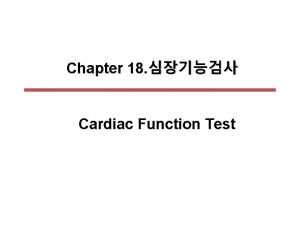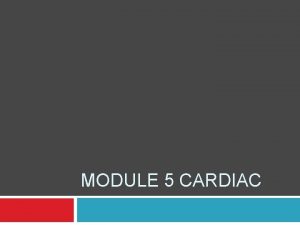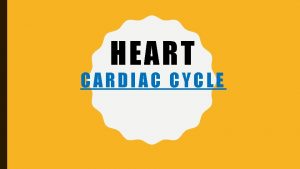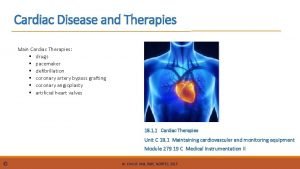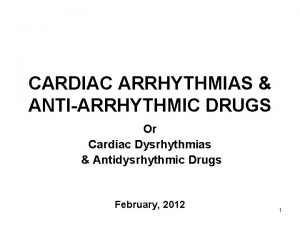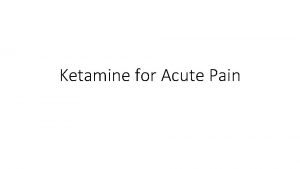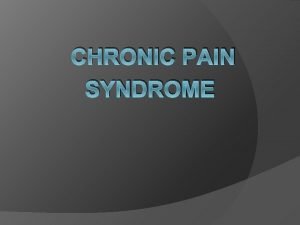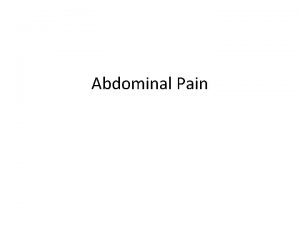Topic 1 pain 2 respiratory drugs 3 cardiac

























































































- Slides: 89



Topic 1 pain 2 respiratory drugs 3 cardiac disease and drugs 4 activated charcoal and sorbotol in poisoning

pain

Acute pain § Pain immediately following an injury to the body is considered § to be acute pain, whereas pain lasting beyond the expected § healing time, or persistent pain that does not respond to usual § pain control methods, is defined as chronic pain

The goal of therapy § Analgesic selection The selection of an analgesic must be individualized for each patient, depending on the cause and chronicity of the pain as well as the patient’s age and concomitant medical conditions that may alter drug response. Furthermore, the clinical response of the patient dictates future dose adjustment, route, and desired dosing interval.

Opioid Analgesics § Managing Side Effects of Opioid Analgesics § The most common side effects reported with the use of opioid § analgesics are nausea, vomiting, itching, and constipation.

Indications § Severe acute pain § ACS (acute coronary syndrome)

Administration § Administered by sub-Q, IM, or slow IV injection, or by IV infusion. § When morphine is administered IV an opiate antagonist and facilities for administration of oxygen and control of respiration should be available. § For IV injection, morphine sulfate should be injected slowly with the patient in the recumbent position. Rapid IV injection may result in an increased frequency of opiate-induced adverse effects; severe respiratory depression, apnea, hypotension, peripheral circulatory collapse, chest wall rigidity, cardiac arrest, and anaphylactoid reactions have occurred following rapid IV injection.

of Administration § Rate Dilution The rate of continuous IV infusion of the drug must be § §For continuous IV infusion, morphine sulfate has been diluted to individualized according to the response and tolerance of a concentration of 0. 1– 1 mg/m. L in 5% dextrose and the patient. via a controlled-infusion device; more administered §concentrated solutions have been used in patients whose fluid Rate of IV infusion in neonates generally should not exceed 0. 015– 0. 02 mg/kg per hour. intake was restricted and/or dosage requirements were high. Morphine sulfate injections containing 25 or 50 mg/m. L are intended for preparation of IV infusion solutions and should not be administered IV without prior dilution. § For continuous sub-Q infusion, the drug has been diluted to an appropriate concentration in 5% dextrose and administered via a portable, controlled, sub-Q infusion device.

Dosage forms of morphine § MORPHINE HCL 10 MG/ML AMP § MORPHINE HCL 20 MG/ML AMP § MORPHINE SULPHATE 10 MG/ML AMP

Pediatric Patients Moderate to Severe Pain § IM or Sub-Q § Neonates: 0. 05– 0. 2 mg/kg every 2– 4 hours as necessary. § Infants and children: 0. 1– 0. 2 mg/kg every 2– 4 hours. § Single pediatric doses should not exceed 10 mg.

§ IV § Neonates: 0. 05– 0. 2 mg/kg every 2– 4 hours as necessary. For continuous IV infusion, 0. 025 – 0. 05 mg/kg per hour. § Infants and children: 0. 1– 0. 2 mg/kg every 2– 4 hours. § Adolescents >12 years of age: 3– 4 mg; may repeat in 5 minutes if needed. § Single pediatric doses should not exceed 10 mg.

Adults § IV § May administer 2. 5– 20 mg every 2– 6 hours as needed or § § via continuous infusion at a rate of 0. 8– 10 mg per hour. Can be administered at a rate of 2– 4 mg every 5 minutes, with some patients requiring as much as 25– 30 mg before pain relief is adequate. IM or Sub-Q May administer 2. 5– 20 mg every 2– 6 hours as needed or via continuous infusion at a rate of 0. 8– 10 mg per hour. Continuous IV

§ Initially 0. 8– 10 mg/hour and then increase to an effective § § dosage as necessary; an IV loading dose of ≥ 15 mg can be administered for initial relief of pain prior to initiating continuous IV infusion of the drug. Maintenance doses have ranged from 0. 8– 80 mg/hour infused IV, although higher (e. g. , 150 mg/hour) maintenance dosages occasionally have been required. Unstable Angina (Unresponsive to 3 Sublingual Doses of Nitroglycerin) IV 2– 5 mg (repeated every 5– 30 minutes as needed to relieve symptoms and maintain patient comfort) has been used.

Prescribing Limits Pediatric Patients Analgesia Moderate to Severe Pain § IV, IM, or Sub-Q § Single pediatric doses should not exceed 15 mg.

Contraindications • Respiratory depression in the absence of resuscitative equipment. • Acute or severe bronchial asthma or hypercarbia. • Known or suspected paralytic ileus.

Warnings Respiratory Depression The major toxicity associated with morphine Head Injury and Increased Intracranial Pressure Hypotensive Effects Hypersensitivity Reactions Anaphylaxis reported rarely Sulfite Sensitivity

Common Adverse Effects GI effects CNS effects dizziness nausea visual disturbances vomiting mental clouding or depression constipation sedation coma faintness dysphoria euphoria weakness insomnia delirium seizures agitation restlessness nervousness

Onset § Sub-Q: Peak analgesia within 50– 90 minutes and maximal respiratory depression within 90 minutes. § IV injection: Peak analgesia within 20 minutes and maximal respiratory depression within 7 minutes. § IM administration: Peak analgesia within 30– 60 minutes and maximal respiratory depression within 30 minutes. § Analgesia may be maintained up to 7 hours.

Solution Compatibility Compatible Dextrose–Ringer’s injection combinations Dextrose–Ringer’s injection, lactated, combinations Dextrose–saline combinations Dextrose 2. 5, 5, or 10% in water Ringer’s injection, lactated Sodium chloride 0. 45 or 0. 9% Variable Sterile water for injection

Metoclopramide HCl Drug Compatibility Furosemide Ondansetron HCl

§ Ketorolac

Indications Management of moderately severe, acute pain in children 2– 16 years of age (single IV or IM dose). Current principles of pain management indicate that analgesics, including ketorolac, should be administered at regularly scheduled intervals, although the drug also has been administered on an as-needed basis (i. e. , withholding subsequent doses until pain returns).

Indications Short-term (i. e. , up to 5 days) management of moderately severe, acute pain that requires analgesia at opiate level in adults.

Administration § Administer IV, IM, or orally in adults; administer IV or IM in children 2– 16 years of age. § Initiate therapy in adults with parenteral (IV or IM) ketorolac; oral formulation is used as continuation therapy, as required. Administer IV or IM as a single dose or every 6 hours; administer orally every 4– 6 hours. § In children 2– 16 years of age, administer as a single IV or IM dose.

Rate of Administration Administer over ≥ 15 seconds. IM Administration Administer IM slowly and deeply into the muscle.

Dosage To minimize the potential risk of adverse cardiovascular and/or GI events, use lowest effective dosage and shortest duration of therapy consistent with the patient’s treatment goals. Adjust dosage based on individual requirements and response; attempt to titrate to the lowest effective dosage. For break through pain, supplement with low doses of opiate analgesics (unless contraindicated) as needed rather than higher or more frequent doses of ketorolac. Amp 15 mg/ml Amp 30 mg/ml

Pediatric Patients Pain Single Dose § IV § Children 2– 16 years of age: One dose of 0. 5 mg/kg (maximum 15 mg). § IM § Children 2– 16 years of age: One dose of 1 mg/kg (maximum 30 mg). § <2 years: safety and efficacy not established

Adults > 16 years, Weight <50 kg § IV 15 mg as single dose or 15 mg q 6 h. not to exceed 60 mg/day. § IM 30 mg as single dose or 15 mg q 6 h. not to exceed 60 mg/day. > 16 years Weight >50 kg § IV 30 mg as single dose or 30 mg q 6 h. not to exceed 120 mg/day. § IM 60 mg as single dose or 30 mg q 6 h. not to exceed 120 mg/day.

Prescribing Limits Pediatric Patients Only a single parenteral dose is recommended. Single Dose IV → 15 mg. IM → 30 mg. § Renal Impairment Single Dose IV → 15 mg. IM → 30 mg.

§ Hepatic Impairment Need for dosage adjustment not fully established; evidence in patients with cirrhosis suggests that dosage adjustment may not be necessary. § Geriatric Patients Dosage recommendations are the same as those for patients with moderately increased Scr or for those weighing <50 kg.

Warnings Increased risk of intramuscular hematoma following IM administration in patients receiving anticoagulants. Concurrent use with prophylactic low-dose heparin (2500– 5000 units every 12 hours), warfarin, or dextrans not studied extensively, but also may be associated with increased risk of bleeding Hypertension and worsening of preexisting hypertension reported, Use with caution in patients with hypertension; monitor BP. Avoid in patients with aspirin triad (aspirin sensitivity, asthma, nasal polyps); caution in patients with asthma.

Storage Injection → 15– 30°C; protect from light. Solution Compatibility Compatible Haloperidol lactate Solution Compatibility Incompatible Morphine Sulfate Compatible Dextrose 5% in sodium chloride 0. 9% Dextrose 5% in water Ringer’s injection, lactated Sodium chloride 0. 9%

Respiratory drugs

Albuterol Sulfate (Salbutamol) Class: Selective beta-2 -Adrenergic Agonists Bronchodilator relatively selective Short-acting β 2 -adrenergic agonist

Indications for Albuterol sulfate § Acute or severe bronchospasm: Symptomatic management or prevention of bronchospasm in patients with reversible, obstructive airway disease (e. g. , asthma). § Exercise-induced Bronchospasm (prevention) § Chronic Obstructive Pulmonary Disease: Albuterol sulfate in fixed combination with ipratropium bromide (combivent): Symptomatic management of reversible bronchospasm associated with COPD in patients who continue to have evidence of bronchospasm despite regular use of an orally inhaled bronchodilator and who require a second bronchodilator.

§ Dosage § Pediatric Patients § Bronchospasm in Asthma § Oral Inhalation Aerosol (100 mcg/dose-200 dose) Children ≥ 4 years of age: 180 mcg (2 inhalations) every 4– 6 hours. Do not increase dosage or dosage frequency. Alternatively, 90 mcg (1 inhalation) every 4 hours may be sufficient.

§ Adults § Bronchospasm in Asthma § Oral Inhalation Aerosol 180 mcg (2 inhalations) every 4– 6 hours. Do not increase dosage or dosage frequency of orally inhaled albuterol aerosol. Alternatively, 90 mcg (1 inhalation) every 4 hours. § Chronic Obstructive Pulmonary Disease § Oral Inhalation Aerosol Initially, 180 mcg (2 inhalations) 4 times daily in fixed combination with ipratropium bromide (18 mcg per inhalation). If necessary, additional inhalations may be used, with dosage not >12 inhalations in 24 hours.

§ Prescribing Limits § Adults § Chronic Obstructive Pulmonary Disease § Oral Inhalation Aerosol Maximum 180 mcg (2 inhalations) 4 times daily in fixed combination with ipratropium bromide (18 mcg per inhalation).

Contraindications § Known hypersensitivity to albuterol or any ingredients in the formulations. § Known history of hypersensitivity to soya lecithin or related food products such as soybeans or peanuts; atropine and its derivatives; or any other ingredient in the specific formulation (albuterol sulfate in fixed combination with ipratropium bromide).

Warnings Paradoxical Bronchospasm Cardiovascular Effects Sensitivity Reactions Pediatric Use Geriatric Use

Common Adverse Effects Albuterol sulfate Tremor muscle cramps asthma exacerbation hypokinesia bronchospasm insomnia nervousness weakness shakiness dizziness otitis media nausea excitement nausea hyperactivity cough increased bronchitis increased appetite headache flu syndrome tachycardia/palpitations lymphadenopathy skin/appendage infection urticaria

Common Adverse Effects Albuterol sulfate in fixed combination with ipratropium bromide Bronchitis chest pain upper respiratory tract infection pain lung disease respiratory disorder headache sinusitis dyspnea nausea pharyngitis diarrhea coughing urinary tract infection influenza pneumonia leg cramps dyspepsia constipation voice alterations bronchospasm

Onset Oral inhalation aerosol: Within 5– 15 minutes

Atrovent Generic Name: Ipratropium Bromide Class: Antimuscarinics/Antispasmodics

Indications § § § Bronchospasm in COPD: maintenance treatment of bronchospasm, including chronic bronchitis and emphysema. Acute asthma exacerbation: Has been used for symptomatic treatment of acute or chronic bronchial asthma; β 2 -adrenergic agonist bronchodilators generally preferred initially for relief of bronchospasm in asthmatic patients. May be useful as alternative therapy in adults experiencing adverse effects (e. g. , tachycardia, arrhythmia, tremor) with a β-adrenergic agonist. Some clinicians consider ipratropium as adjunctive therapy in patients with moderate or severe exacerbations (peak expiratory flow rate ≤ 80% of predicted) of asthma who fail to respond adequately to β-adrenergic agonists and corticosteroids. May be useful for prevention or reversal of bronchospasm induced by βadrenergic blocking agents (e. g. , propranolol) in asthmatic patients; βadrenergic bronchodilators generally ineffective for this indication in such patients.

Atrovent Dosage and Administration Acute asthma exacerbation: 8 actuations (136 mcg) q 20 min PRN for 3 hr. Contraindications • Known hypersensitivity to the drug or any other component of the formulation, or to atropine or its derivatives. • Known hypersensitivity to soya lecithin or related food products, including soybeans and peanuts.

Warnings Acute Bronchospasm Delayed onset of action; not indicated for initial treatment. Generally should not be used alone for the management of acute bronchospasm, when a rapid response is required. Sensitivity Reactions Immediate hypersensitivity reactions, including rash, angioedema of the tongue, lips, and face, urticaria, bronchospasm, oropharyngeal edema, and anaphylactic reaction. Possible paradoxical bronchospasm.

Common Adverse Effects Bronchitis upper respiratory tract infection cough dryness of the mouth throat, or tongue with ipratropium aerosol Adverse effects resulting in discontinuance of nebulized ipratropium most frequently include bronchitis, dyspnea, and bronchospasm Onset Bronchodilation evident within 15 minutes following oral aerosol inhalation and within 15– 30 minutes following oral inhalation via nebulization

Cardiac disorders and drugs

TNG (trinitroglycerin sublingual pearl 0. 4 mg, trinitroglycerin sublingual spray 0. 4 mg) pharmacology: relaxes smooth muscle via dosedependent dilation of arteial and venous beds to reduce both preload and afterload, and myocardial O 2 demand. Also improve cronary collateral circulation. lower BP, increase HR, occasional paradoxial bradycardia.

§ Dosage and Indications (pearl) Angina Pectoris (acute relief): 0. 3 -0. 6 mg q 5 min up to 3 times, use at first sign of angina. prompt medical attention needed if no relief. dissolve under tongue or in buccal pouch, do not rinse mouth or spit for 5 minutes after administration. Angina Pectoris (prophylaxis) (Angina Pectoris: is the result of myocardial ischemia caused by an imbalance between myocardial blood supply and oxygen demand. it is a common presenting symptom (typically chest pain) among patients with coronary artery disease (CAD). signs and symptoms: retrosternal chest discomfort (pressure, heaviness, squeezing, burning, or chocking sensation

§ Dosage and Indications (pearl) pain localized primarily in the epigastrium, back, neck, jaw or sloulders. pain precipitated by exertion, eating, expsure to cold, or emotional stress, lasting for about 1 -5 minutes and relieve by rest or nitroglycerin. pain intensity that does not change with respiration, cough or change in position)

Dosage and Indications (spray) § 1 -2 sprays PRN for angina, may repeat q 3 -5 min not to exceed 3 sprays in 15 minutes. § spray onto or under tongue, do not inhale expectorate or rinse mouth for 5 -10 minutes. § seek medical attention if pain persists after 3 doses in 15 minutes.

Common Adverse Effects headache blurred vision hypotension flushing tachycardia nervousness dizziness xerostomia Contraindications • Early myocardial infarction , severe anemia, increased intracranial pressure, and known hypersensitivity to nitroglycerin • Recent use (within several days) of PDE-5 inhibitors ( sildenafil & tadalafil) may cause dangerously low hypotension • Narrow angle glaucoma • Acute circulatory failure or shock

§ Amiodarone § Class: Class III Antiarrhythmics § Delays repolarization by prolonging the action potential duration and effective refractory period in cardiac tissue. § Amp 150 mg/3 ml

§ Indications § Ventricular Arrhythmias § Used during cardiac arrest for treatment of refractory (i. e. , unresponsive to CPR, defibrillation, and a vasopressor [e. g. , epinephrine]) VF or pulseless VT. Considered the preferred antiarrhythmic drug for this use in current ACLS guidelines in ; adults lidocaine may be used as an alternative. In pediatric patients, current evidence supports use of either amiodarone or lidocaine. § Also may be used for treatment of wide-complex tachycardias during periarrest period; included in current ACLS guidelines for both adult and pediatric tachycardia. § Supraventricular Tachyarrhythmias

§ Amiodarone Hydrochloride Dosage and Administration

§ IV Administration Administer in 3 -phase sequence: rapid loading phase, slow loading phase, and maintenance infusion phase. Dilute amiodarone hydrochloride concentrate prior to administration by IV infusion. § Dilution For the first rapid loading infusion or for supplemental infusions, add 3 m. L of amiodarone hydrochloride concentrate to 100 m. L of 5% dextrose, resulting in a final concentration of 1. 5 mg/m. L.

§ For the slow loading infusion and maintenance infusion, add 18 m. L of amiodarone hydrochloride concentrate to 500 m. L of 5% dextrose, resulting in a final concentration of 1. 8 mg/m. L. For subsequent maintenance infusions, solutions containing a final amiodarone hydrochloride concentration of 1– 6 mg/m. L may be used.

§ Rate of Administration For treatment of ventricular arrhythmias in adults, 15 mg/minute for 10 minutes (rapid loading phase), then 1 mg/minute for 6 hours (slow loading phase), then 0. 5 mg/minute (initial maintenance phase) for 18 hours; infuse supplemental doses of 150 mg over 10 minutes (at a rate of 15 mg/minute). Initial (rapid) loading infusion rate should not exceed 30 mg/minute. Monitor initial rate of infusion closely; do not exceed recommended rate. (See Hypotension under Cautions. ) Use volumetric infusion pump. Do not use drop-counter infusion sets; may result in underdosage.

§ Pediatric Patients § Ventricular Arrhythmias § Pediatric Resuscitation Refractory VF or pulseless VT: 5 mg/kg as a rapid bolus. May repeat twice up to 15 mg/kg (maximum single dose of 300 mg). To minimize pediatric exposure to DEHP, may infuse a loading dose of 5 mg/kg given in 5 divided doses of 1 mg/kg (each dose infused over 5– 10 minutes). § Adults Total initial dosage during first 24 hours is approximately 1000 mg.

IV Dosage Over First 24 Hours Loading Phase Initial rapid loading phase: 150 mg administered at rate of 15 mg/minute (i. e. , over 10 minutes) Maintenance Phase First maintenance phase: 540 mg administered at rate of 0. 5 mg/minute (i. e. , over 18 hours)

Prescribing Limits Pediatric Patients Ventricular Arrhythmias IV Maximum single dose: 300 mg, up to a total dose of 15 mg/kg. Adults Ventricular Arrhythmias IV Mean daily doses >2. 1 g are associated with an increased risk of hypotension.

Geriatric Patients Select dosage with caution, usually starting at low end of dosage range, because of possible age-related decrease in hepatic, renal, and/or cardiac function and concomitant disease and drug therapy; however, dosage requirements generally similar in geriatric and younger adults. Use caution with high dosages due to increased susceptibility to drug-induced bradycardia and conduction disturbances.

Contraindications Cardiogenic shock. Severe sinus node dysfunction resulting in marked sinus bradycardia (unless a functioning pacemaker is present). Second- or third-degree AV block (unless a functioning pacemaker is present). (See Effects on Cardiac Conduction under Cautions. ) Bradycardia that has caused syncope (unless a functioning pacemaker is present). Known hypersensitivity to amiodarone or any ingredient in the formulation, including iodine.

§ Warnings Common Adverse Effects IV administration: hypotension Arrhythmogenic Effects Hypotension Storage Parenteral Compatible Injection Concentrate Dextrose 5% in water 20– 25°C; protect from light and excessive heat. Store ampuls in carton to protect from light until used. Light protection not necessary during administration.

§ Lidocaine as an alternative for Amiodarone Dosage & Indication Acute management of ventricular arrhythmias (acute MI). Adult 1 -1. 5 mg/kg slow IV bolus over 2 -3 minutes. May repeat doses of 0. 5 -0. 75 mg/kg in 5 -10 minutes up to 3 mg/kg total if refractory VF or pulseless VT. Continuous infusion: 1 -4 mg/min IV after return of perfusion. Administer 0. 05 mg/kg bolus reassess infusion if arrhythmia reappears during constant infusion.

pediatric patients § Bolus: 0. 5 -1 mg/kg IV not to exceed 100 mg, follow with contiuous infusion, if delay between bolus and start of infusion is>15 minutes administer a second bolus q 5 -10 min to 5 mg/kg § Continuous infusion: 20 -50 mcg/kg/min IV


Indications for Epinephrine § Sensitivity Reactions § ACLS and Cardiac Arrhythmias § Septic Shock § Bronchospasm

Epinephrine Dosage and Administration § Dosage § Pediatric Patients § Sensitivity Reactions § Anaphylaxis § IM or Sub-Q 0. 01 mg/kg (0. 01 m. L/kg of a 1 -mg/m. L solution) (up to 0. 3– 0. 5 mg per dose depending on patient weight); repeat every 5– 15 minutes as needed. Some clinicians state that doses may be repeated at 20 -minute to 4 -hour intervals depending on severity of the condition and patient response

IV If necessary, initial dose of 0. 01 mg/kg (0. 1 m. L/kg of a 0. 1 mg/m. L solution) may be administered. If repeat doses are required, initiate a continuous IV infusion at a rate of 0. 1 mcg/kg per minute; increase gradually to 1. 5 mcg/kg per minute to maintain BP. Pediatric Advanced Life Support (PALS) IV or IO Neonates: Usual IV dose is 0. 01– 0. 03 mg/kg (0. 1– 0. 3 m. L/kg of a 0. 1 -mg/m. L solution). Higher doses not recommended because of risk of exaggerated hypertension, decreased myocardial function, and worsening neurologic function

Pediatric patients: Usual IV/IO dose is 0. 01 mg/kg (0. 1 m. L/kg of a 0. 1 mg/m. L solution), up to a maximum single dose of 1 mg, repeated every 3– 5 minutes as needed. Lack of survival benefit and potential harm from routine use of higher doses, particularly in cases of asphyxia. However, may consider high-dose epinephrine in exceptional circumstances (e. g. , βadrenergic blocking agent overdose). § For postresuscitation stabilization in pediatric patients, usual dosage is 0. 1– 1 mcg/kg per minute by IV/IO infusion; adjust based on patient response. Low-dose infusions (<0. 3 mcg/kg per minute) generally produce predominantly β-adrenergic effects, while higher-dose infusions (>0. 3 mcg/kg per minute) result in α-adrenergic vasoconstriction. § For emergency treatment of infants and children with bradycardia and cardiopulmonary compromise (with a palpable pulse), may give 0. 01 mg/kg (0. 1 m. L/kg of a 0. 1 -mg/m. L solution) by IV/IO injection, repeated every 3– 5 minutes as needed. §

Septic Shock IV If epinephrine is used in pediatric patients, some clinicians have recommended an infusion rate of 0. 05– 0. 3 mcg/kg per minute, titrated to effect. When therapy is discontinued, decrease infusion rate gradually (e. g. , by reducing every 30 minutes over a 12 - to 24 - hour period). Bronchospasm IV Neonates: 0. 01 mg/kg by slow IV injection has been recommended. Infants: Initially, 0. 05 mg by slow IV injection; may repeat every 20– 30 minutes as needed

Adults Sensitivity Reactions Anaphylaxis IM or Sub-Q Usual dose is 0. 2– 0. 5 mg (0. 2– 0. 5 m. L of a 1 -mg/m. L solution); repeat every 5– 15 minutes as needed. IV In extreme circumstances (e. g. , anaphylactic shock, cardiac arrest, or no response to initial IM injections), IV administration may be necessary. Usual IV dose is 0. 1– 0. 25 mg (1– 2. 5 m. L of a 0. 1 -mg/m. L solution); repeat every 5– 15 minutes as necessary. Alternatively, may administer as a continuous infusion at a rate of 2– 15 mcg/minute; titrate based on severity of the reaction and clinical response.

Cardiac Arrest IV or IO ACLS guidelines recommend 1 mg every 3– 5 minutes by IV/IO injection. Higher doses (e. g. , 0. 1– 0. 2 mg/kg) do not provide any benefits in terms of survival or neurologic outcomes compared with the standard dose (1 mg) and may be harmful. Optimal timing of administration, particularly in relation to defibrillation, not known and may vary based on patient-specific factors and resuscitation conditions. In adults with asystole or PEA, may administer as soon as feasible after onset of cardiac arrest based on studies demonstrating improved survival to hospital discharge and increased ROSC when the drug is administered early during course of treatment for a nonshockable rhythm. For postresuscitation stabilization, usual IV dosage is 0. 1– 0. 5 mcg/kg per minute; adjust based on patient response.

Bradycardia: IV For symptomatic bradycardia, initial IV infusion rate of 2– 10 mcg/minute has been recommended; adjust according to patient response. Septic Shock IV Manufacturer suggests IV infusion of 0. 05– 2 mcg/kg per minute. May increase infusion rate by 0. 05– 0. 2 mcg/kg per minute every 10– 15 minutes to achieve desired BP goal. Duration of therapy or total dose required not known; treatment may be necessary for several hours or days until the patient's hemodynamic status improves. When therapy is discontinued, decrease infusion rate gradually (e. g. , by reducing every 30 minutes over a 12 - to 24 -hour period). Bronchospasm IV 0. 1– 0. 25 mg (1– 2. 5 m. L of a 0. 1 -mg/m. L solution) injected slowly.

Prescribing Limits Pediatric Patients Sensitivity Reactions Anaphylaxis IM or Sub-Q Maximum for pediatric patients: 0. 3– 0. 5 mg of epinephrine per dose depending on weight. Pediatric Resuscitation IV/IO Maximum single dose of 1 mg. Adults Sensitivity Reactions Anaphylaxis IM or Sub-Q Single doses should not exceed 0. 5 mg.

Compatible Ringer’s injection, lactated Dextrose–Ringer’s injection combinations Sodium chloride 0. 9% Dextrose–Ringer’s injection, lactated, combinations Sodium lactate 1/6 M Dextrose 5% in Ringer’s injection, lactated Incompatible Dextrose–saline combinations Sodium bicarbonate 5% Dextrose 5% in sodium chloride 0. 9% Incompatible Dextrose 2. 5, 5, or 10% in water Aminophylline Ringer’s injection

Atropine • ACLS and Bradyarrhythmias Atropine Dosage and Administration Administer by sub-Q, IM, or direct IV injection. IV administration preferred for treatment of severe or life-threatening muscarinic effects. Administer by direct IV injection. Occasionally has been administered by IV infusion for management of muscarinic poisoning Preferably give IV injections rapidly because slow injection may cause a paradoxical slowing of the heart rate.

Pediatric Patients Premedication for Bradycardia in Emergency Intubation IV Infants and children: AHA recommends a preintubation dose of 0. 02 mg/kg (with no minimum). Although minimum dose of 0. 1 mg was previously recommended because of concerns about paradoxical bradycardia, current evidence suggests that minimum dose not necessary. PALS and Bradyarrhythmias IV Infants and children with symptomatic bradycardia secondary to increased vagal activity or primary AV block: 0. 02 mg/kg; repeat once if needed. PALS guideline recommends minimum dose of 0. 1 mg and maximum single dose of 0. 5 mg. Larger doses may be required in special resuscitation situations (e. g. , organophosphate toxicity or exposure to nerve gas agents) and smaller doses (i. e. , <0. 1 mg) may cause paradoxical bradycardia.

Adults ACLS and Bradyarrhythmias Bradycardia IV For symptomatic bradycardia, AHA recommends initial dose of 0. 5 mg; may repeat every 3– 5 minutes up to 3 mg. Doses <0. 5 mg may cause paradoxical slowing of heart rate.

Prescribing Limits Pediatric Patients PALS and Bradyarrhythmias Bradycardia Infants and children: AHA recommends maximum single dose of 0. 5 mg. Adults: IV Maximum total dose of 3 mg recommended

Compatible Sodium chloride 0. 9% Compatible Furosemide Sodium bicarbonate

Charcoal, Activated Indications overdose, poisoning 1 g/kg, 25 -100 g PO alternatively 10 g charcoal/1 g drug ratio minimum dose: 25 g commonly used with Sorbitol 25 g, multiple dose regimen 25 g PO q 2 hr or 50 g q 4 hr without sorbitol. Do not give sorbitol after first dose do to risk for severe diarrhea. use aqueous solution. May place into ice to improve taste, mix 1: 3 soda for pediaterics

Common Adverse Effects black stool, constipation Contraindications Intestine obstruction, unprotected airway(aspiratin may occur), caustic ingestion Vomiting may occur. Charcoal Dosage forms Tab 250 mg, SUSP 300 g/240 ml, SUSP 50 g Sorbitol Dosage forms Sorbitol 5 g sachet, sorbitol oral solution

 Conducting zone respiratory
Conducting zone respiratory Pharmacology of drugs acting on respiratory system
Pharmacology of drugs acting on respiratory system Are sore breasts and cramps a sign of pregnancy
Are sore breasts and cramps a sign of pregnancy Early pregnancy symptoms cramps
Early pregnancy symptoms cramps Madpain
Madpain Research problem example for students
Research problem example for students Clincher sentence examples
Clincher sentence examples A cardiac monitor is used to measure
A cardiac monitor is used to measure Intercalated disc
Intercalated disc Digitalis use
Digitalis use Cardiac muscle
Cardiac muscle Cotton rings and hand rolls definition
Cotton rings and hand rolls definition Refractory period
Refractory period Name the tissue type
Name the tissue type Aschoff bodies diagram
Aschoff bodies diagram Heart tube
Heart tube Spread of cardiac impulse
Spread of cardiac impulse Characteristics of skeletal smooth and cardiac muscle
Characteristics of skeletal smooth and cardiac muscle What tissue is this
What tissue is this Cardiac rehab phase 1
Cardiac rehab phase 1 Tripod position
Tripod position Cardiac cycle graph
Cardiac cycle graph Ebevlet
Ebevlet Cardiac output trained vs untrained
Cardiac output trained vs untrained Cardiac muscle striations
Cardiac muscle striations Cardiac orifice of stomach
Cardiac orifice of stomach One complete heartbeat is known as
One complete heartbeat is known as Cardiac cycle steps
Cardiac cycle steps Cpmc cardiac rehab
Cpmc cardiac rehab Dobutamine vs dopamine
Dobutamine vs dopamine Cardiac output
Cardiac output Cardiac pico question examples
Cardiac pico question examples Cardiac cycle
Cardiac cycle Amputation bed uses
Amputation bed uses Properties of cardiac muscle
Properties of cardiac muscle Cardiac vegetation definition
Cardiac vegetation definition T tubules
T tubules Mets score cardiac
Mets score cardiac Cardiac arrest reason
Cardiac arrest reason Andre lapeyre
Andre lapeyre 3 lobes of lungs
3 lobes of lungs Cardiac muscle contraction
Cardiac muscle contraction Adult chain of survival
Adult chain of survival Enlarged cardiac silhouette
Enlarged cardiac silhouette Cardiac output
Cardiac output Cardiac conduction
Cardiac conduction Smooth muscle contraction vs skeletal muscle contraction
Smooth muscle contraction vs skeletal muscle contraction Cardiac massage definition
Cardiac massage definition Cardiac cycle
Cardiac cycle Cardiac plexus
Cardiac plexus Vo2r formula
Vo2r formula Cardiac rehab itp template
Cardiac rehab itp template Homometric regulation of cardiac output
Homometric regulation of cardiac output Fick principle cardiac output
Fick principle cardiac output Cardiac output
Cardiac output Code crimson hospital
Code crimson hospital Gastroesophageal junction
Gastroesophageal junction Cardiac distension
Cardiac distension Nursing bed positions for patients
Nursing bed positions for patients Pericardiodesis meaning
Pericardiodesis meaning Teixit muscular cardiac
Teixit muscular cardiac Comparison of skeletal cardiac and smooth muscle
Comparison of skeletal cardiac and smooth muscle Lab 7 the muscular system
Lab 7 the muscular system Phase 2 cardiac rehab exercises
Phase 2 cardiac rehab exercises Refractory period in heart
Refractory period in heart Spread of cardiac excitation
Spread of cardiac excitation Cardiac muscle striations
Cardiac muscle striations Ucsf cardiac anesthesia
Ucsf cardiac anesthesia Pericardial friction
Pericardial friction Lateral head
Lateral head Lesson 6: cardiac emergencies and using an aed
Lesson 6: cardiac emergencies and using an aed Phosphodiesterase inhibitors nursing implications
Phosphodiesterase inhibitors nursing implications Cardiac muscle tissue
Cardiac muscle tissue Mammillated areas of stomach
Mammillated areas of stomach Moat house surgery
Moat house surgery Wap rhythm
Wap rhythm Keith rischer
Keith rischer Torrance memorial human resources
Torrance memorial human resources Cardiac output and stroke volume
Cardiac output and stroke volume Gittata sistolica
Gittata sistolica Cardiac workload
Cardiac workload Cardiac muscle
Cardiac muscle Pathfast hsctni
Pathfast hsctni Lidocaine in cardiac arrest
Lidocaine in cardiac arrest Stroke volume
Stroke volume Cardiac output definition
Cardiac output definition Cardiac output trained vs untrained
Cardiac output trained vs untrained Ertapenem
Ertapenem Jones and bartlett ekg strips 2012
Jones and bartlett ekg strips 2012 Cardiac glycoside
Cardiac glycoside







